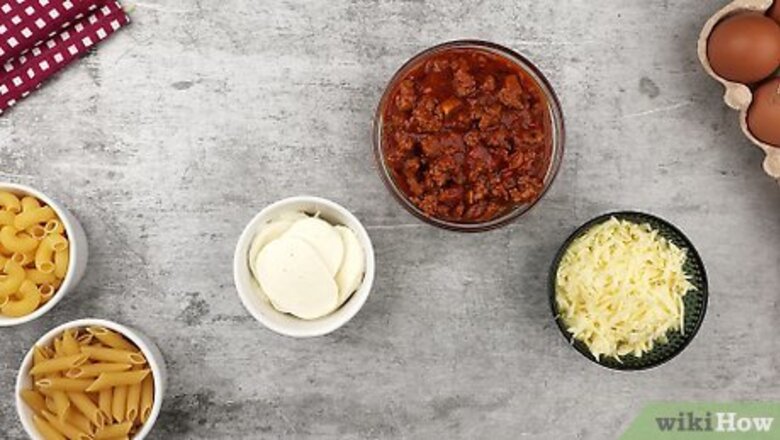
views
- Start by spreading a thin layer of sauce on the bottom of your baking dish.
- Then, place your lasagna noodles on top without overlapping the edges and pour on another helping of sauce.
- Lastly, spread a layer of ricotta and shredded cheese over the sauce before repeating the process.
Preparation
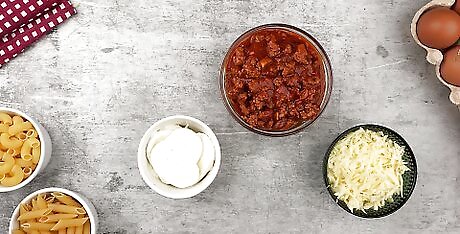
Gather your ingredients. Before you begin layering your lasagna, consider placing each of your ingredients in bowls. This way, they’ll be easier to grab when you assemble your dish. Clear off your workspace, and then separate your ingredients into individual bowls. If you’re making a meat lasagna, make sure your meat is fully cooked. Minced beef, chicken, or pork can make excellent additions to your lasagna. If you’re making a vegetarian lasagna, consider laying out sliced mushrooms, zucchini, or fresh spinach to add to your layers.

Choose a no-boil or regular lasagna noodle. When it comes to lasagna, there are 2 types of noodles to choose from: no-boil or regular. Regular noodles must be cooked before assembling your lasagna, whereas no-boil noodles don’t. If you’re looking for a faster way to make lasagna, opt for no-boil noodles. Cook regular lasagna noodles following the instructions on the box. No-boil noodles cook with your lasagna, so you may need extra sauce to fully saturate them.
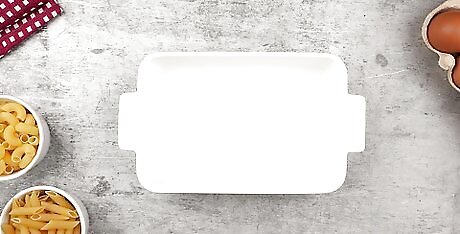
Opt for a wide, deep dish pan. The larger and wider your pan, the better. Lay an uncooked noodle over the pan you’d like to use. If you can fit 2 or more noodles next to each other in the pan, it’s perfect. If the noodles overlap, consider switching to a different pan, as overlapping noodles could create a gummy texture. Keep in mind that a deep dish requires a longer cooking time, especially when compared to a shallow dish. Use a glass dish to help your lasagna cook more evenly, as glass distributes and traps heat better than metal pans, which can quickly lose heat.
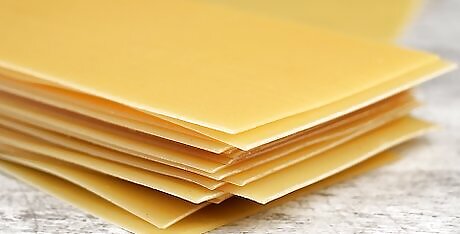
Cook regular lasagna noodles and let them cool. If you’re using no-boil noodles, skip this step; otherwise, follow the instructions on the back of your noodle packet to boil your noodles. Once fully cooked, pull the noodles out of the pot, drain them, and lay them out to cool. Run cold water over the steaming noodles to speed up the cooling process. Drizzle olive oil between each cooked noodle so they don’t stick together. Consider cutting the cooked and cooled noodles with a kitchen scissor or sharp knife to fit your baking dish better.

Mix ricotta cheese with eggs. Traditionally, lasagna gets its ooey-gooey cheesy goodness from a mixture of ricotta cheese and eggs. Add a container of ricotta cheese into a bowl and crack in 1 egg. This gives your cheese filling a fluffy texture while providing extra flavor. Try adding other seasonings to your cheese mixture, like salt, pepper, parmesan cheese, or nutmeg. It’s better to make too much ricotta cheese than not enough! If you have leftover cheese filling after assembling your lasagna, consider using it to make baked spaghetti or ziti dish.
Assembling Your Lasagna
Smother the bottom of the pan with sauce. Believe it or not, your lasagna's first layer contains no noodles. Use a spoon to scoop your desired sauce into the baking dish. Spread it evenly along the bottom. This will keep your noodles from sticking. Try to distribute the meat chunks of your sauce evenly, but don’t fret too much if it isn’t perfect.
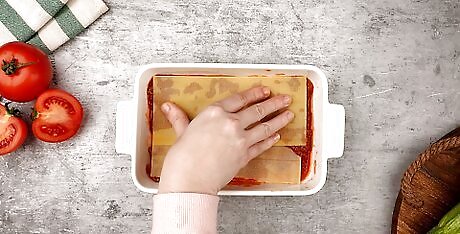
Lay noodles over the sauce without overlapping them. Now it’s time to start assembling. Drape noodles over the sauce one at a time, as close to the edge of the pan as possible. Leave a bit of space next to each noodle, as overlapping the noodles could create a tough or gummy texture. Use as many noodles as it takes to cover the base of the pan.
Spread another layer of sauce evenly over the noodles. Grab another spoonful of sauce and dump it in the middle of each noodle. The more sauce you add, the softer and juicier your lasagna will be—just remember to keep the layers thin so you can add multiple layers.
Spread and sprinkle cheese over the sauce layer. Plop a dollop of your ricotta cheese mixture over the sauce and spread it out. Then, drizzle a shredded cheese of your choice on top of the sauce. Keep sprinkling cheese until the previous sauce layer is completely covered. Use shredded mozzarella, Italian, Parmigiano, Reggiano, or parmesan cheese, or go wild and try a mixture of them all. Make your lasagna extra cheesy by adding slices of mozzarella or extra dollops of ricotta on top of the shredded cheese.
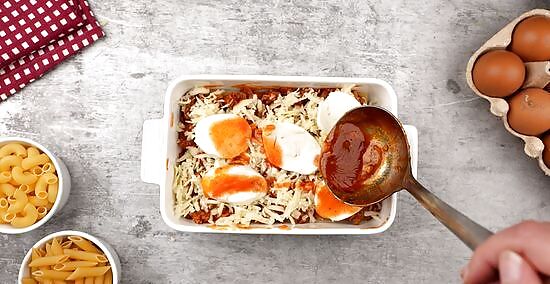
Drench the cheese in another spoonful of sauce. Pour another layer of your sauce over the cheese layer until it’s covered. Create an even layer (just like before); otherwise, your lasagna may become too runny.
Continue layering your lasagna with noodles, sauce, cheese, and sauce. Repeat the layering process until you’ve reached the top of your baking dish. The number of layers your lasagna has depends on the amount of filling you use and the depth of your dish. Aim to have at least 3 full layers of sauce, cheese, and noodles in your lasagna. Reserve enough noodles and cheese to cover the top of your final layer.
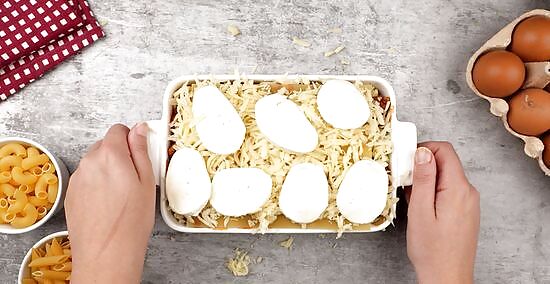
Top the lasagna with 1 more layer of noodles and cheese. Once your pan is completely layered, finish the lasagna with a final layer of noodles and cheese. Think of this as the lasagna’s lid. Use the same number of noodles you used in the base layers, and then sprinkle the rest of your cheese on top. Finishing with a cheese layer gives your lasagna that perfectly golden and bubbly cheese-pulling top. Try sprinkling sweet paprika, parsley, or oregano over the cheese before baking for added flavor and garnish. If you’re using no-boil noodles, consider adding another thin layer of sauce over the top noodles before sprinkling on the cheese to help the noodles cook.
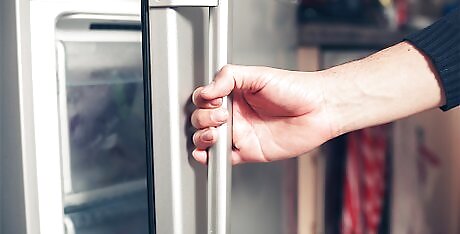
Bake your lasagna or store it for later. The beautiful thing about lasagna is that it can be cooked and enjoyed whenever! Pop your lasagna in the oven for about 1 hour to enjoy the day you assembled it, or cover the dish with aluminum foil to store in the freezer for 3 months or in the fridge for up to 3 days. Check the back of your lasagna noodle box for what temperature and how long to bake your lasagna for. Make sure to defrost a frozen lasagna completely before baking; otherwise, it may need to cook longer.
Recipe Variations

Try different sauces. Bolognese or red meat sauce is the traditional and most popular sauce used to make lasagna; however, that doesn’t mean it’s the only sauce you can use. Spice up your lasagna dish by using a red veggie sauce or cheesy white sauce. Who knows? You may discover something delicious! Make an alfredo sauce to pair with shredded chicken for a cozy and comforting white sauce lasagna.

Add different cheeses. For an interesting and innovative twist, swap out ricotta cheese for cottage cheese or shredded mozzarella with shredded colby jack or slice provolone. Use whatever you have in the fridge to create a mix-and-match lasagna. After all, you can’t go wrong with cheese.

Trade lasagna noodles for ravioli. Craving lasagna but don’t have lasagna noodles? Well, try this innovative and utterly delicious hack! Raviolis are already flat and packed with cheesy goodness, so what could go wrong? Simply swap the traditional noodles with frozen ravioli while layering. Like no-boil lasagna noodles, the ravioli doesn’t need to be cooked first—just layer the frozen pasta into the pan. Try using ravioli stuffed with mushrooms, meat, or veggies for extra flavor.
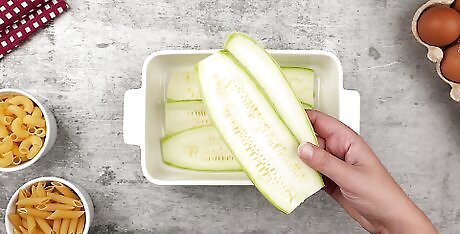
Swap noodles with sliced zucchini. This low-carb, gluten-free option will please any veggie lover. Instead of layering your lasagna with noodles, thinly slice a zucchini with a mandoline to mimic noodles. Crisp them up in the oven or air fryer before assembling or layering them with sauce raw.

Add seafood to your lasagna’s filling. If you’re craving a bit of salty ocean flavor, try this clever hack! Instead of beef, chicken, or pork, toss chunks of crab, shrimp, or lobster in your sauce. This is a great way to enjoy your favorite seafood with a classic Italian dish. Opt for a creamy white sauce instead of a red sauce if you try this hack, as red sauces can easily overpower seafood flavors.
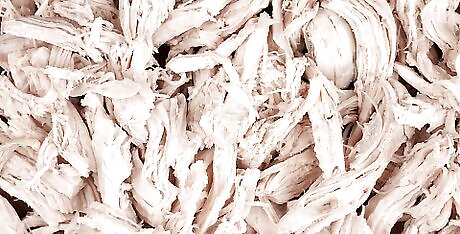
Toss leftovers into the filling. Lasagnas are a great way to empty the fridge. Have leftover chicken or steak from a previous dinner? Chop it up and toss it in between noodles. Need to use an onion, pepper, or tomato? Dice them up and sprinkle them over a layer of sauce. Think of what you like in regular pasta dishes, and don’t be afraid to experiment. Keep in mind that adding more ingredients to your lasagna layers may increase the cooking time.



















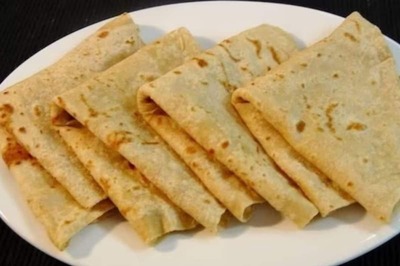
Comments
0 comment